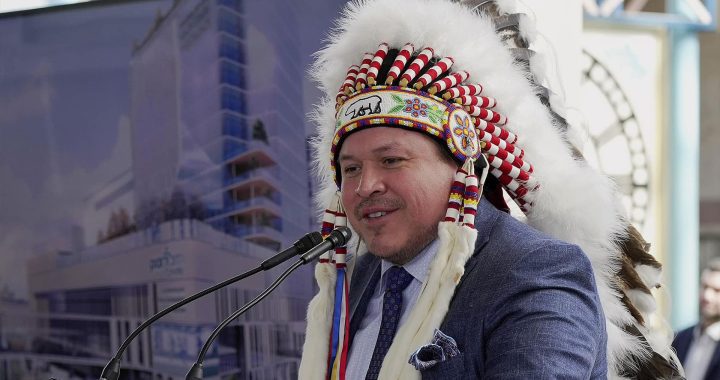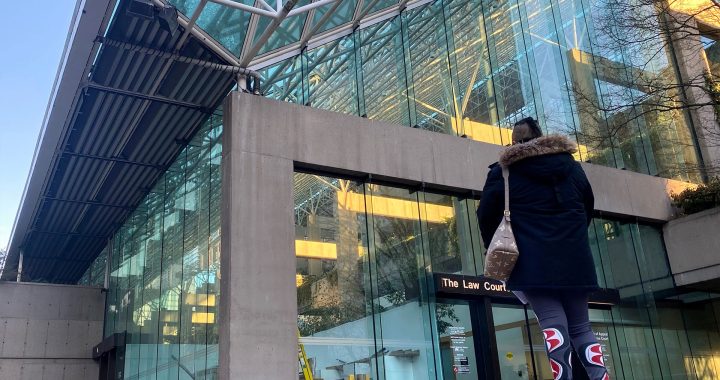Gerri Sharpe was just nine years old when she sold her first oopik (a crafted owl) to the Co-op for a bag of chips.
Now she fills orders for sealskin parkas to hats to mittens with colourful entarga inlay patterns.
“I prefer working with seal over other fabrics and hides,” she said.
Sharpe originally hails from ᐅᖅᓱᖅᑑᖅ – Gjoa Haven, a small Inuit hamlet in Nunavut whose place name translates to “lots of fat” because of the abundance of sea mammals surrounding the community.
She is one of eight artisans taking part in a multi-day Nattiq Sealebration, workshop, aimed at refining sewing skills to create high-quality products for local markets.
(Gerri Sharpe, makes her very first hand cuff, interlacing sealskin and leather. Photo: Charlotte Morritt-Jacobs/APTN)
In its second year, the program is run by the NWT’s Industry, Tourism and Investment (ITI) department and funded by the Department of Fisheries and Oceans CMAPS (Certification and Market Access Program for Seals) program. It’s led by the renowned Dene designer D’Arcy Moses who brings his 25 plus years of experience working in fashion houses to the table.
“The ladies are learning different techniques on making a nice, marketable product and finishing techniques so their work is professional, for example, as opposed to raw seam allowances and lining it professionally,” Moses said.
Sharpe carefully sews her loom beadwork through a thick piece of reposted fur.
Just like traditional sewing circles, the women give creative suggestions on design and technique.
“I already had the beadwork done and had three different pieces. I asked everyone what they thought and everyone gave me some information. If it wasn’t for this I wouldn’t have done up the purse that way,” Sharpe said.
Susie Nakashuk-Zettler holds the fur back and removes stitching with her needle.
“I started sewing a lot of mitts by hand but now i’m trying to use the sewing machine. Last year I was so excited and rushed but this year I am taking my time,” she said.
Nakashuk-Zettler is originally from ᐸᖕᓂᖅᑑᖅ Pangnirtung Nunavut, where her mother would sew winter gear out of ring seal.
The workshop is set up in an empty storefront in the downtown mall in Yellowknife. The highly visible space is where the public stops and watches the artists at work.
From Moses, participants are also learning how to sell their wares at a price reflective of the quality and effort of their work.
“I was undervaluing my art maybe because the way I grew up everything was given to people who needed it. You need mitts or a jacket so selling was tough but I am learning to sell,” Nakashuk-Zettler said.
(Susie Nakashuk-Zettler calls sealskin sewing instructor D’Arcy Moses ‘absolute gold,’ as she learns alongside other northern Indigenous women on how to elevate her craft. Photo: Charlotte Morritt-Jacobs/APTN)
Johanna Tiemessen, manager of arts and crafts in IT said the workshop showcases the importance of seal to Inuit culture to the public and helps bolster a better fur industry for northern artists.
“In order for us to have a sustainable fur industry we have to ensure artists have access to affordable materials and that they have a market to sell those materials for a value that matches the work they have put into it and the materials used,”
The participants are gifted with the materials needed for their creations through the workshop,
Moses’ said supporting Indigenous artists will help combat the decline of sales and support efforts against climate change.
“When I first set foot in Yellowknife in 1996, there was a lot more fur on the streets. I saw fur coats and trim, now it has all changed. Fur is a renewable resource, it feeds families, its non-polluting. The second largest polluter on the planet is fast fashion. The big issue for globally now is repurposing.
Sharpe also teaches mitten making workshops and noted the educational experience as a factor in combating misconceptions around seal created by organizations such as Peta (People for the Ethical Treatment of Animals).
“Every type of workshop is going to have conversation about culture and what things were like, how things are caught and what you do with things. Either with artists or to the public that conversation happens naturally,” she said.
With the knowledge acquired at the workshop, Sharpe finishes up her handbag, a piece that has taken hours to complete.
She said each piece she crafts tells a story, and is sewn traditionally with a modern twist of new techniques she has picked up in workshops such as this.











